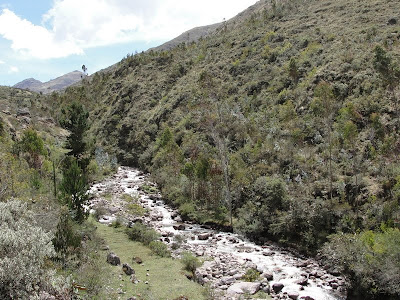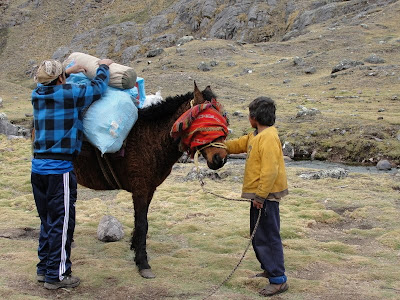We hoped that we would be able to arrive in Cusco and book a trek on the world famous Inca Trail. We knew that in the high season (June-September), trekkers have to save their spots on the trail several months in advance. Since we arrived just as low season began, we thought there might be a couple spots available. Well....nope! Travel agencies and tour operators repeatedly told us that the Inca Trail was out of the question, and that we had several "alternative treks" to choose from. None of the alternative treks are paths that lead directly into Machu Picchu (only the Inca Trail offers that stunning ending), but there are several treks in the area that end up in Aguas Calientes, where trekkers then take a bus to Machu Picchu.
The trek we chose was called the Lares Valley Trek, often referred to us a "cultural" trek because it's not just a walk through nature, but also a journey through several indigenous communities who continue to live much as they've been living for hundreds of years. Another awesome thing about this route is that it's one of the least touristy ones. Few people choose this trek, so especially during low season it's super peaceful and special.
Let me begin at the beginning. Our trek began with an early morning drive out of Cusco, through the Sacred Valley, and finally to the in-the-middle-of-nowhere Lares Hot Springs.


The place was incredibly peaceful. There were six different pools, all filled with mineral water, each pool at a different temperature.

Before relaxing in the mineral waters, our cook prepared breakfast for us and our guide. It felt really weird to be served like that, but that's just part of what you pay for when you book a trek. Anyway, we ate our breakfast as the clouds cleared and the sun began to beat down. Then we got in our swimsuits and soaked in the waters for a very long time. Of course, we were joking, "Man, that was a hard trek." It felt kind of silly to begin our journey by relaxing in such peaceful luxury.
Later on in the morning, a group of at least 40 kindergartners and two teachers arrived. I couldn't get over how amazing it was that they were taking a field trip to the hot springs. Actually, I couldn't take my eyes off this group. The interaction between the two male teachers and all the 5-year-olds was fascinating. These young kids were not only extremely respectful to their teachers and to each other, I noticed that they were also very quiet. No one complained. No one fought or cried. I was in disbelief! This was the first beautiful moment of the trek where I got a glimpse of this other culture that is full of living values.
All the kids took showers in the little "waterfalls" beside the mineral pools. The water was warm and constantly flowing, something that none of these kids have in their homes. The teachers stood and watched and made sure every single child thoroughly shampooed his or her hair, and scrubbed every exposed inch of skin with soap. It was amazing. These teachers cared so much about those kids getting clean.

One of the teachers must have noticed my undivided attention given to those little students. He approached me and we exchanged teacher-talk for a while. This was so awesome. First of all, I had the opportunity to compliment him. I could see that he was such a caring teacher, he truly gave with all his heart. Then, I got to ask him all the questions I could think of, that I was able to say in Spanish. He was so eager to answer me (and even invited me to the school!) and from him I learned that all the kids in the school are extremely poor. They come from the indigenous villages surrounding Lares. Most of them walk for several miles (literally) every day to get to school. All the teachers at the school have to be bilingual because many of the students don't speak Spanish very well (only Quechua is spoken at home). Most of them stay in school for a few years, until they learn to read and write, and then stay at home to help their families with farm work. It was a really interesting conversation, and it made me so happy to have that exchange with such an enthusiastic person serving an indigenous community.
After a few hours at the hot springs, we began the actual trekking part of our trek, at 3,100 m. Our cook went a different route, where he met our horseman (whom we later learned was in fact a horseboy) and the two horses that carried our camping equipment and food.
Day One of trekking consisted of three hours of walking gradually uphill, but also occasionally on flat ground. The views of the Lares Valley were incredible. Our guide stopped occasionally to tell us about different plants and how the Incas used them.

 At around 3pm, we arrived at the tiny indigenous village of Huacahuasi (3,800 m), which was where we were going to camp for the night.
At around 3pm, we arrived at the tiny indigenous village of Huacahuasi (3,800 m), which was where we were going to camp for the night.
Ryan, of course, immediately bought a beer:

Our tents set up, just before it got crazy windy and cold:



We slept well in our tent that night. We were exhausted from waking up at 2:30am that morning! On Day Two, we were up by 6am, getting ready for the longest and hardest day of the trek.




It was hard to leave those kids, in a way. They were so grateful for the tiniest things we gave them. It was really neat to be able to spend one evening and one morning in their world.
We began walking shortly after 7am. This was the hardest day because we had to get over the highest pass of the entire journey, 4,400 m (14,435 ft). The beginning was really incredible because as we were leaving the village, we passed by llamas and alpacas!





Ryan leading the way:

Taking a break, enjoying the view:



The sleet gave way to rain when we stood at the highest point, and neither of us took the risk of taking out our cameras. Instead, we stood at the highest point for a minute, and then began the steep descent down the other side of the mountain. The rain and sleet turned the winding path into a muddy, flowing stream. I was so scared that I was going to slip! Of course, I was the slowest one. By far.
Eventually, the rain/sleet mostly stopped. Here is what we saw before us as we descended from the pass:




The walk from the lunch spot to our camp site was entirely downhill and no big deal. We arrived at around 4pm or so, and it was starting to get cold. That night was really, really, really cold. We put on all our layers!


Day Three was quite easy. The entire trek was downhill, which meant that our calves were killing us by the end of the day. It was really awesome, though, to see how the landscape and temperature changed as we descended into the Sacred Valley.



Our trek ended mid-day of Day Three. We arrived at Yanahuara and celebrated with a traditional Inca corn drink called chicha (the red one is strawberry flavored!)

It was an amazing adventure! We saw so many beautiful pieces of nature and culture.
We took the train from Ollantaytambo to Aguas Calientes (the town closest to Machu Picchu). I wanted to include Machu Picchu here, but this has already gotten so long, and I think Machu Picchu deserves an entry of its own.
















